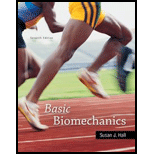
Concept explainers
A sailboat heads north at 3 m/s for 1 hour and then tacks back to the southeast (at 45° to north) at 2 m/s for 45 minutes.
a. How far has the boat sailed?
b. How far is it from its starting location?
(a)
To find: The distance sailed by the boat in north and south east direction.
Answer to Problem 10AP
The total distance sailed in north and southeast direction is
Explanation of Solution
Calculation:
Write an expression to find the distance sailed by the boat in north direction.
Substitute
Thus, distance sailed by the boat in north direction is
Write an expression to find the distance sailed by the boat in southeast direction.
Substitute
Thus, distance sailed by the boat in southeast direction is
Write an expression to find the total distance sailed in north and southeast direction.
Substitute
Therefore, the total distance sailed in north and southeast direction is
(b)
To find: The distance of the boat from its starting location.
Answer to Problem 10AP
The distance of the boat from its starting location is
Explanation of Solution
Calculation:
Write an expression to find the distance of the boat from its starting location.
Draw the diagram to illustrate the situation in this problem.

Substitute 10.8 km for B and 5.4 km for C to find the distance of the boat from its starting location.
Therefore, the distance of the boat from its starting location is
Want to see more full solutions like this?
Chapter 1 Solutions
Basic Biomechanics
 Principles Of Radiographic Imaging: An Art And A ...Health & NutritionISBN:9781337711067Author:Richard R. Carlton, Arlene M. Adler, Vesna BalacPublisher:Cengage LearningCase Studies In Health Information ManagementBiologyISBN:9781337676908Author:SCHNERINGPublisher:Cengage
Principles Of Radiographic Imaging: An Art And A ...Health & NutritionISBN:9781337711067Author:Richard R. Carlton, Arlene M. Adler, Vesna BalacPublisher:Cengage LearningCase Studies In Health Information ManagementBiologyISBN:9781337676908Author:SCHNERINGPublisher:Cengage Cardiopulmonary Anatomy & PhysiologyBiologyISBN:9781337794909Author:Des Jardins, Terry.Publisher:Cengage Learning,
Cardiopulmonary Anatomy & PhysiologyBiologyISBN:9781337794909Author:Des Jardins, Terry.Publisher:Cengage Learning,





